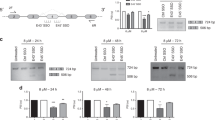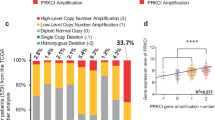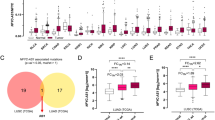Abstract
Expression of the RIα subunit of cAMP-dependent protein kinase type I is increased in human cancers in which an autocrine pathway for epidermal growth factor-related growth factors is activated. We have investigated the effect of sequence-specific inhibition of RIα gene expression on ovarian cancer cell growth. We report that RIα antisense treatment results in a reduction in RIα expression and protein kinase A type I, and inhibition of cell growth. The growth inhibition was accompanied by changes in cell morphology and appearance of apoptotic nuclei. In addition, EGF receptor, c-erbB-2 and c-erbB-3 levels were reduced, and the basal and EGF-stimulated mitogen-activated protein kinase activities were reduced. Protein kinase A type I and EGF receptor levels were also reduced in cells overexpressing EGF receptor antisense cDNA. These results suggest that the antisense depletion of RIα leads to blockade of both the serine-threonine kinase and the tyrosine kinase signaling pathways resulting in arrest of ovarian cancer cell growth.
This is a preview of subscription content, access via your institution
Access options
Subscribe to this journal
Receive 50 print issues and online access
$259.00 per year
only $5.18 per issue
Buy this article
- Purchase on Springer Link
- Instant access to full article PDF
Prices may be subject to local taxes which are calculated during checkout




Similar content being viewed by others
References
Aaronson SA. . 1991 Science 254: 1146–1153.
Alper Ö, Agrawal S and Cho-Chung YS. . 1998 Proc. Am. Assoc. Cancer Res. 39: 646.
Beebe SJ and Corbin JD. . 1986 In: The Enzymes: Control by Phosphorylation, Part A, vol. 17. Boyer PD and Krebs EG (eds).. Academic Press: New York pp. 43–111.
Budillon A, Cereseto A, Kondrashin A, Nesterova M, Merlo G, Clair T and Cho-Chung YS. . 1995 Proc. Natl. Acad. Sci. USA 92: 10634–10638.
Chen J and Iyengar R. . 1994 Science 263: 1278–1281.
Cho-Chung YS, Clair T, Tagliaferri P, Ally S, Katsaros D, Tortora G, Neckers L, Avery TL, Crabtree GW and Robins RK. . 1989 Cancer Invest. 7: 161–177.
Cho-Chung YS, Nesterova M, Kondrashin A, Noguchi K, Srivastava R and Pepe S. . 1997 Antisense Nucl. Acid Drug Dev. 7: 217–223.
Cho-Chung YS. . 1990 Cancer Res. [Perspectives in Cancer Research] 50: 7093–7100.
Cho-Chung YS. . 1996 Antisense Nucl. Acid Drug Dev. 6: 237–244.
Ciardiello F, Tortora G, Kim N, Clair T, Ally S, Salomon DS and Cho-Chung YS. . 1990 J. Biol. Chem. 265: 1016–1020.
Ciardiello F, Dixit M, di Isernia G, Damiano V, Bianco R, Bianco AR, Arteaga CL and Tortora G. . 1998 Br. Cancer Res. Treat. 47: 57–62.
Cobb CE, Beth AH and Corbin JD. . 1987 J. Biol. Chem. 262: 16566–16574.
Cook SJ and McCormick F. . 1993 Science 262: 1069–1072.
Davis RJ. . 1993 J. Biol. Chem. 268: 14553–14556.
Dean N, McKay R, Miraglia L, Howard R, Cooper S, Giddings J, Nicklin P, Meister L, Ziel R, Geiger T, Muller M and Fabbro D. . 1996 Cancer Res. 56: 3499–3507.
Guyton KZ, Gorospe M, Kensler TW and Holbrook NJ. . 1996 Cancer Res. 56: 3480–3485.
Krebs EG and Beavo JA. . 1979 Annu. Rev. Biochem. 48: 923–939.
Levy FO, Oyen O, Sandberg M, Tasken K, Eskild W, Hansson V and Jahnsen T. . 1988 Mol. Endocrinol. 2: 1364–1373.
Lohmann SM and Walter U. . 1984 In: Advances in Cyclic Nucleotide and Protein Phosphorylation Research, vol. 18. Greengard P and Robison GA (eds).. Raven Press: New York pp. 63–117.
McKnight GS, Clegg CH, Uhler MD, Chrivia JC, Cadd GG, Correll LA and Otten AD. . 1988 Recent Prog. Horm. Res. 44: 307–335.
Metelev V, Lisziewicz J and Agrawal S. . 1994 Bioorganic Med. Chem. Lett. 4: 2929–2934.
Monia BP, Johnston JF, Geiger T, Muller M and Fabbro D. . 1996 Nature Med. 2: 668–675.
Nesterova M and Cho-Chung YS. . 1995 Nature Med. 1: 528–533.
Nesterova M, Yokozaki H, McDuffie E and Cho-Chung YS. . 1996 Eur. J. Biochem. 253: 486–494.
Otten AD, Parenteau LA, Doskeland S and McKnight GS. . 1991 J. Biol. Chem. 266: 23074–23082.
Pegues JC and Stromberg K. . 1997 Cancer Lett. 117: 73–79.
Schwartz DA and Rubin CS. . 1985 J. Biol. Chem. 260: 6296–6303.
Srivastava RK, Srivastava AR, Park YG, Agrawal S and Cho-Chung YS. . 1998 Breast Cancer Res. Treat. 49: 97–107.
Stein CA. . 1995 Nature Med. 1: 1119–1121.
Sturgill TW, Ray LB, Erikson E and Maller JL. . 1988 Nature (Lond.) 334: 715–718.
Tortora G, Ciardiello F, Ally S, Clair T, Salomon DS and Cho-Chung YS. . 1989 FEBS Lett. 242: 363–367.
Tortora G, Yokozaki H, Pepe S, Claire T and Cho-Chung YS. . 1991 Proc. Natl. Acad. Sci. USA 88: 2011–2015.
Tortora G, Damiano V, Bianco C, Baldassarre G, Bianco AR, Lanfrancone L, Pelicci PG and Ciardiello F. . 1997 Oncogene 14: 923–928.
Wu J, Dent P, Jelinek T, Wolfman A, Weber MJ and Sturgill TW. . 1993 Science 262: 1065–1068.
Yokozaki H, Budillon A, Tortora G, Meissner S, Beaucage SL, Miki K and Cho-Chung YS. . 1993 Cancer Res. 53: 868–872.
Acknowledgements
We thank Dr Sudhir Agrawal (Hybridon, Inc., Milford, MA, USA) for providing the oligonucleotides and Dr Joyce Pegues (FDA, Bethesda, MD, USA) for her kind help in the construction of EGF-receptor expression vectors. This research was supported in part by a grant from the Gynaecological Cancer Fund of the Royal Hospital Foundation.
Author information
Authors and Affiliations
Rights and permissions
About this article
Cite this article
Alper, Ö., Hacker, N. & Cho-Chung, Y. Protein kinase A-Iα subunit-directed antisense inhibition of ovarian cancer cell growth: crosstalk with tyrosine kinase signaling pathway. Oncogene 18, 4999–5004 (1999). https://doi.org/10.1038/sj.onc.1202830
Received:
Revised:
Accepted:
Published:
Issue Date:
DOI: https://doi.org/10.1038/sj.onc.1202830
Keywords
This article is cited by
-
Regulatory subunits of PKA define an axis of cellular proliferation/differentiation in ovarian cancer cells
BMC Medical Genomics (2008)
-
Lysophosphatidic acid and endothelin-induced proliferation of ovarian cancer cell lines is mitigated by neutralization of granulin–epithelin precursor (GEP), a prosurvival factor for ovarian cancer
Oncogene (2005)
-
Antisense DNAs as targeted genetic medicine to treat cancer
Archives of Pharmacal Research (2003)



